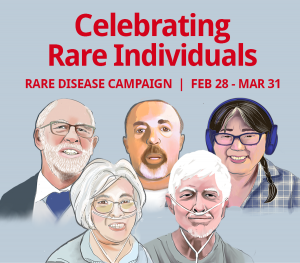
We are all unique individuals tied together by our dedication to a better life for people living with pulmonary fibrosis (PF). We each deal with the challenges of living with this life-changing disease or caring for a person with PF with courage, resiliency and compassion.
Pulmonary fibrosis is considered a rare disease, just one of the rare diseases that affect nearly three million Canadians. The Canadian Pulmonary Fibrosis Foundation (CPFF) is conducting its Rare Disease Campaign from February 28, which was Rare Disease Day, until March 31, 2022.

During our Rare Disease Campaign we invite you to help us celebrate rare individuals, by sharing your stories and theirs and by making a tribute or memorial donation to your “rare” individual and sending them an e-card.
As part of the campaign, we’ve created and released an informative and inspiring, 30-minute documentary called Breathless for Change, featuring people living with pulmonary fibrosis talking about how their lives have changed.
“Many of the key messages in this campaign, as well as clips from the documentary, will be used to raise awareness and funds to help advocate for more equitable access to diagnosis, treatment, support and opportunity for people living with PF,” says Sharon Lee, CPFF’s Executive Director.
“I encourage you to support your friends and family members during this campaign,” she says. “And please share the link to the campaign and documentary on your social media accounts.”
Creating universal blood-type organs for transplant

You may not have to wait as long for a lung transplant following the promising results of a recent “proof-of-concept” study into creating universal type O blood lungs. Researchers at UHN (University Health Network) in Toronto proved it is possible to convert blood type safely in donor organs intended for transplantation.
“This finding is an important step towards creating universal type O organs, which would significantly improve fairness in organ allocation and decrease mortality for patients in the waitlist,” according to a February 16, 2022, UHN news release.
“With the current matching system, wait times can be considerably longer for patients who need a transplant depending on their blood type,” explains Dr. Marcelo Cypel, Surgical Director of the Ajmera Transplant Centre at UHN and the senior author of the study.
“Having universal organs means we could eliminate the blood-matching barrier and prioritize patients by medical urgency, saving more lives and wasting less organs,” adds Dr. Cypel.
“With no cure for pulmonary fibrosis, and lung transplantation the last possible treatment to prolong life, the possibility of removing the blood-type barrier for lung recipients may literally be a life-saver for those living with PF now and those still to be diagnosed, as well as their families,” says Sharon Lee, Executive Director of Canadian Pulmonary Fibrosis Foundation (CPFF).
Blood type is determined by the presence of antigens on the surface of red blood cells — type A blood has the A antigen; B has the B antigen; AB blood has both antigens; and O has none. Antigens can trigger an immune response if they are foreign to our bodies. That is why for blood transfusions we can only receive blood from donors with the same blood type as ours, or universal type O.
Likewise, antigens A and B are present on the surfaces of blood vessels in the body, including vessels in solid organs. If someone who is type O (meaning they have anti-A and anti-B antibodies in their bloodstream) received an organ from a type A donor, for example, the organ in all likelihood would be rejected. Consequently, donor organs are matched to potential recipients in the waitlist based on blood type, among other criteria.
In the UHN study, human, type A, donor lungs, not suitable for transplantation, were put in the Ex Vivo Lung Perfusion (EVLP) system, which pumps nourishing fluids through the organs, enabling them to be warmed to body temperature, so that they can be repaired and improved before transplantation.
One lung was treated with a group of enzymes to clear the antigens from the surface of the organ, while the other lung, from the same donor, remained untreated. The enzymes removed more than 97 per cent of blood type A antigens within four hours.
The team then tested each of the lungs by adding type O blood (with high concentrations of anti-A antibodies) to the circuit, to simulate an ABO-incompatible transplant. The results demonstrated that the treated lungs were well tolerated while the untreated ones showed signs of rejection.
The enzyme process was developed by University of British Columbia biochemist Dr. Stephen Withers and his team in 2018 to convert red blood cells for transfusions. Cypel’s team tested the enzymes in blood and then in a human aorta. Once they saw success, they moved onto a whole organ.
The researchers are optimistic that the first clinical trials of the procedure could happen within the next 12 to 18 months.
You can find out more about innovations in IPF treatments, including lung transplantations, in the 2021 CPFF video “Therapies for IPF – from pills to lung transplantation,” featuring Dr. Shane Shapera and Dr. Shaf Keshavjee, both of UHN.
U of C developing a universal questionnaire to identify inhaled exposure risks

An 18-month, four-stage, research project is now underway at the University of Calgary to build a universal questionnaire that can be used by clinicians with patients to identify inhaled environmental and occupational risk factors for pulmonary fibrosis.
“Inhaled environmental and occupational exposures are important risk factors for pulmonary fibrosis,” says Dr. Kerri Johannson, director of research for the university’s interstitial lung disease (ILD) program.
“Right now, there is no single questionnaire available for this purpose, particularly nothing rooted in recent evidence, or that has been validated for clinical or research purposes,” she explains.
The research project aims to establish a relevant questionnaire identifying risk factors that matter today and that can be used by clinicians to accurately and efficiently assess risk factors in clinic, without the need to ask 1,000 questions.
It can be difficult for patients to recall, on the spot in clinic, all of the relevant environmental exposures that may have happened over their lifetime, so the questionnaire may be a form that patients take home to complete.
Most doctors have little training in occupational health or environmental exposure assessment,” says Dr. Johannson, “so we want to develop a concise tool that helps them collect relevant exposure information to guide their diagnosis and treatment plans.”
The first stage of the project involves a systematic review and meta-analysis of the medical literature to identify all known occupational and environmental exposures associated with fibrotic lung disease.
In the second stage, the research team will synthesize all published ILD questionnaires that physicians and research centres are using.
In stage three, the team will collaborate with ILD and environmental/occupational experts globally to prioritize and rank inhaled exposures to establish consensus and build one comprehensive questionnaire designed to pinpoint those specific exposures, both environmental and occupational. This component of the study aims to be inclusive, involving expertise from traditionally under-represented areas.
The final stage will be to test the questionnaire within selected clinics to evaluate its ease of use and performance in comparison to other currently used exposure-assessment tools. The final questionnaire will be available for public use across the PF Community.
The new questionnaire would likely be used during the initial assessment by a respiratory specialist. The exposure data collected would be also be useful in looking for trends in inhaled exposures in those with PF, says Dr. Johannson.
The research team expects that the information gathered through the questionnaires on inhaled exposures will be not only useful in treating individual patients, but collectively help researchers identify certain exposures and help them understand which exposures trigger or worsen the symptoms or progression of different types of ILDs and pulmonary fibrosis.
“Ultimately, well beyond the creation of the questionnaire, the information should help researchers determine how to reduce the impacts of inhaled exposures,” says Dr. Johannson. “And by informing governments, industries and the public of exposures linked to PF, we could all work to modify some factors for disease and potentially prevent some forms of PF.”
“It all comes down to the quality of the air we breathe,” she adds. “What we inhale in all our environments – outdoors, at home and at work – has an impact on our lung health, and we need to bring more attention to this risk factor for ILDs and pulmonary fibrosis.”
CPFF will keep you informed if this project requires study participants for the pilot project stage and when the project wraps up and a new inhaled exposure questionnaire becomes available.
This research project is funded by the Three Lakes Foundation, a non-profit, based in the US, that is dedicated to serving as a catalyst for uniting researchers, industries and philanthropy in pulmonary fibrosis. The foundation connects entrepreneurs, advocates and institutions to an innovation ecosystem that will transform our approach and improve time to diagnosis and accelerate new therapies.
CPFF provides input to advisory panel for potential pan-Canadian formulary

In July 2021, CADTH (Canadian Agency for Drugs and Technologies in Health) convened an advisory panel to provide Health Canada with a recommended framework for developing a potential pan-Canadian prescription drug list or formulary.
On January 18, 2022, the Canadian Pulmonary Fibrosis Foundation (CPFF) participated in an online information session on the panel’s work so far, hosted by the advisory panel and CADTH via Zoom. Interest was high, with more than 1,000 people joining the session. A coordinated, pan-Canadian drug formulary has been advocated by many sectors for several years now, as a step towards equitable access to medications across the country.
In advance of the session, a discussion paper summarizing the panel’s interim recommendations was made available for review. An online questionnaire was completed and submitted by CPFF last month. You can find both the discussion paper and the questionnaire online. Reponses to the questionnaire will be posted to the CADTH site, but the timing is unknown.
We will keep you posted as this work by CADTH continues.
Safeguarding your mental wellness under shifting tides

That’s the title of the February 10, 2022, edition of the COVID-19 Virtual Q&A series of videos produced by UHN (University Health Network) Foundation in Toronto. Moderated by Christian Cote, this video features Dr. Susan Abbey, Psychiatrist -in-Chief and Dr. Alon Vaisman, infection control physician, both of UHN.
As COVID-19 case numbers go down, along with hospitalizations and deaths, we seem to be moving into a “learning to live with the virus” phase. Vaccinations and exposure mean most people have developed some immunity to current and emerging variants.
For people with compromised immune systems or chronic illnesses, as well as many seniors, fear of the virus is still a factor in getting “back to normal.” Dr. Vaisman advices individuals to consider that almost 90 per cent of the adult population in Canada has been vaccinated. Also, check the cases counts, hospitalizations and deaths in your local public health area. If they are low, so too is your risk of being infected.
“It will still be more challenging to get back to normal for the most vulnerable people,” says Dr. Vaisman. “And as restrictions and lockdowns disappear, it is best to protect yourself as you would during flu season. Wear a mask when indoors in public areas. Get vaccinated for COVID-19, the flu and pneumonia. Avoid crowds and others who are sick.”
Dr. Abbey talked about focusing on the positive. Things are much better than they were earlier in the pandemic. Work on building resiliency. It is like a muscle that requires exercise and that you can build it through exercise. If you are feeling overwhelmed, do something, take action.
“If you can’t wash all the dishes, just wash one,” she explains. “Avoid personalizing the pandemic, it’s not just happening to you. It is a temporary situation. And, think about what you need right now to feel better. Maybe get a good night’s sleep, take a walk or get a drink of water.”
She also mentioned other coping tips that can be found online such as such as connecting with friends and family online, helping others, following a routine and getting outdoors.
If you are struggling with anxiety or depression, reach out for help. Across the country, mental health services have been expanded to help people deal with pandemic-related mental health issues and some of those services are being covered by provincial health plans. In Ontario, Bounce Back and Mind Beacon are two such online services. Ask your physician, respiratory care team, or local public health unit about mental health services in your area.
A CPFF educational video featuring social worker Kamara Tayo-Jones also offers some practical suggestions on coping with loss and changes. You may also consider joining a CPFF support group to help you manage PF and mental health challenges and cope with isolation.
When asked about what individuals can do to help workers in the health care system continue to cope with staffing shortages, low morale and challenging circumstances, Dr. Abbey and Dr. Vaisman said a simple thank you to anyone doing their job (or filling in for someone else) goes a long way. “I’ve been making a point of thanking everyone I encounter during my days at UHN. The cleaners, my colleagues, nurses, admin assistants, people in the food court, everyone,” says Dr. Abbey. It’s another reminder to continue to be kind to one another.
The next UHN video COVID-19 Virtual Q&A will look at how we’re doing after almost two years since the WHO declared a pandemic. This edition, called Two years later: Learning to live with the virus, will feature Dr. Susy Hota, medical director, infection prevention and control, infectious disease specialist at UHN. The livestream video will be held Thursday, March 10, 2022 from 5 to 6 p.m. EST. You can register online, send in your questions in advance and listen online or by telephone. You can also watch the video after the live broadcast.
You can find a listing of national and provincial public health agencies on the “Helpful Links” page of the “COVID-19 section” on the CPFF website. You’ll also find other videos and articles on COVID-19.
New resource for those referred for lung transplant

Dr. Marco Mura, staff respirologist, Western University and London Health Science Centre, has written a manual in lay language to help pulmonary fibrosis patients and their caregivers, navigate the transition of care as they await a lung transplant. It is titled: “Transition of care for pulmonary fibrosis patients. Candidate for lung transplant. An educational manual for patients and caregivers.”
As he mentions in the manual preface, the period of transition when a patient is referred for lung transplantation can be very stressful with uncertainties about qualifying for a transplant, time for listing and surgery and possible outcomes. All while continuing to live with a progressively life-altering disease.
“I thought that a practical manual to help navigate a period of transition that is at the same time stressful and hopeful would be of some use,” writes Dr. Mura. The manual integrates pre-transplant advice from several professionals in a variety of disciplines, including a dietitian, physiotherapist, psychotherapist, palliative care physician and a CPFF support group coordinator.
While the manual is not meant to replace a full guide on lung transplantation as provided by lung transplant programs, and focuses primarily on those who will undergo transplant in Toronto, it does offer insights for anyone beginning, or considering, the lung transplant journey.
The manual was funded by an unrestricted educational grant from F. Hoffman-La Roche Canada Ltd.


